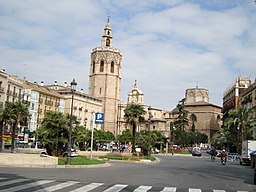
Valencia
Valencia is a well-known Spanish city, the third largest in the country in terms of size, after Madrid and Barcelona. At the same time, quite understandably, it is also the capital of the province of the same name and also of the Valencian Community. Valencia itself has about 810,000 permanent residents, and if we take into account the entire urban agglomeration, it totals just over a million people.
Given the location of the city, it is not surprising that the classic Mediterranean climate with hot summer and mild winter clearly prevails here. If you go anywhere in the Costa del Azahar for your holiday, you must not miss a visit to Valencia.
Public transport Valencia
Like other major cities, Valencia relies on public transport to get around the city. For tourists, it is very convenient, because there is no need to worry about complicated parking of their own car.
The backbone of public transport in Valencia is the local metro. The underground railway has six lines, thanks to which you can get practically anywhere within the city. The metro is then complemented by trams and buses.
Sights in Valencia
Cathedral of the Virgin Mary – an interesting building that dates back to the thirteenth century. It is built on the site of an earlier mosque.
Llotja de la Seda – is the only building in Valencia that is inscribed on the UNESCO World Heritage List.
Districts of Valencia
Like all major cities, Valencia is divided into smaller administrative units. In this case, it is a total of 19 districts and 87 neighborhoods.
- Ciutat Vella (La Seu, La Xerea, El Carmen, El Pilar, El Mercado, San Francisco)
- Eixample (Russafa, El Pla del Remei, Gran Via)
- Extramurs (El Botànic, La Roqueta, La Pechina, Arrancapins)
- Campanar (Campanar, Les Tendetes, El Calvari, Sant Pau)
- La Saïdia (Marxalenes, Morvedre, Trinitat, Tormos, Sant Antoni)
- Pla del Real (Exposició, Mestalla, Jaume Roig, Ciutat Universitària)
- Olivereta (Nou Moles, Soternes, Tres Forques, La Fontsanta, La Luz)
- Patraix (Patraix, Sant Isidre, Vara de Quart, Safranar, Favara)
- Jesús (La Raiosa, L’Hort de Senabre, The Covered Cross, Saint Marcelino, Real Way)
- Quatre Carreres (Montolivet, En Corts, Malilla, La Font de Sant Lluís, Na Rovella, La Punta, Ciutat de les Arts i les Ciències)
- Poblats Marítims (El Grau, El Cabanyal, El Canyameral, La Malva-Rosa, Beteró, Nazaret)
- Camins del Grau (Aiora, Albors, Creu del Grau, Camí Fondo, Penya-Roja)
- Algiròs (Illa Perduda, Ciutat Jardí, Amistat, Vega Baixa, la Carrasca)
- Benimaclet (Benimaclet, Camí de Vera)
- Rascanya (Orriols, Torrefiel, Sant Llorenç)
- Benicalap (Benicalap, Ciutat Fallera)
- Pobles del Nord (Benifaraig, Poble Nou, Carpesa, Cases de Bàrcena, Mauella, Massarrojos, Borbotó)
- Pobles de l’Oest (Benimàmet, Beniferri)
- Pobles del Sud (Forn d’Alcedo, Castellar-l’Oliveral, Pinedo, el Saler, el Palmar, el Perellonet, la Torre, Faitanar)
Transportation to Valencia
The fastest and most convenient way to get to Valencia is by air. The local international airport is about 8 kilometers from the city in the village of Manises. For Valencia to be the third most populous city, it is “only” the tenth busiest airport in the country. Low-cost airlines are used by Smartwings and Wizzair. From the airport to the city can be reached by bus, metro or taxi.
